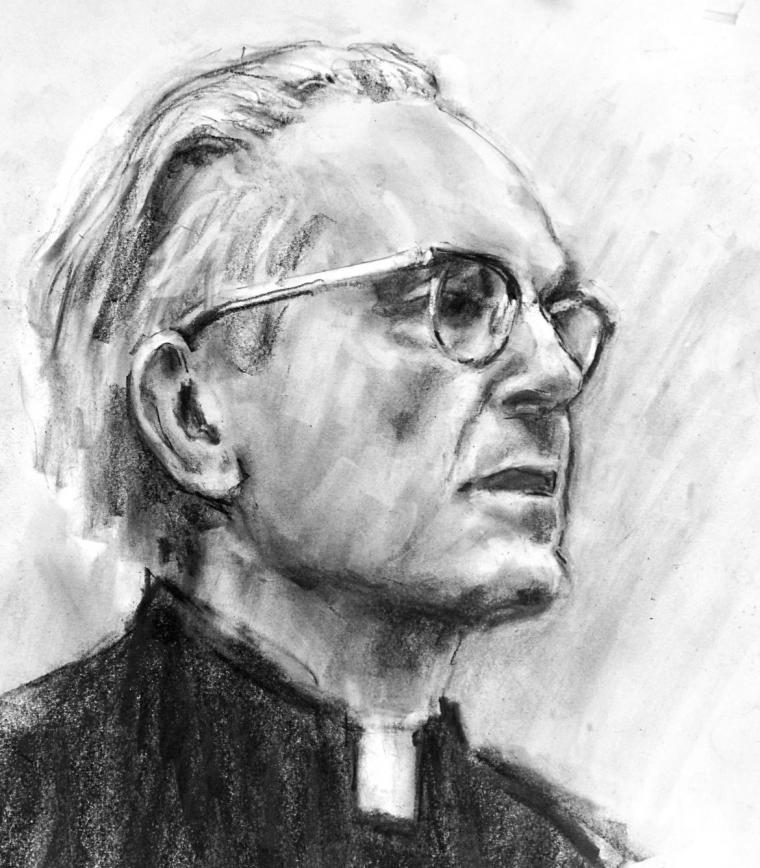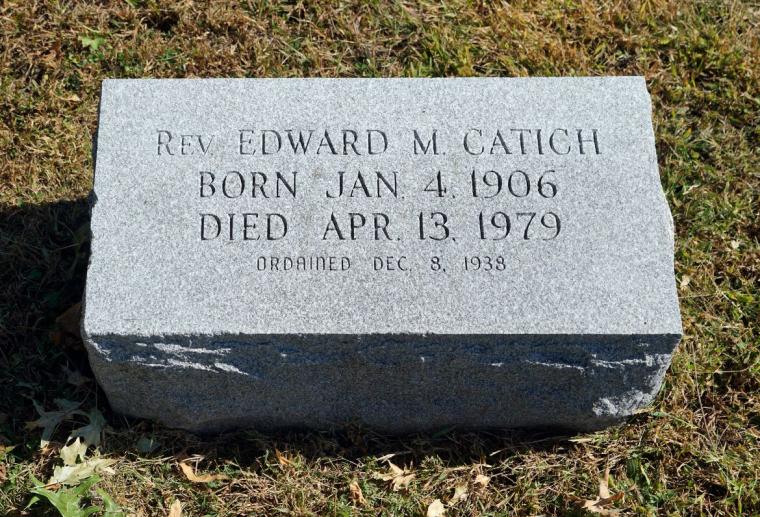
Father Edward M. Catich drawing by Bruce Walters
Nedde Catich was a young jazz musician when he came to St. Ambrose College (now St. Ambrose University) during the Great Depression. At the time, he was playing trumpet in a jazz band at the Purple Grackle, a roadhouse just over the Cook County line. A respite for Chicago gangsters.
He came to St. Ambrose to study to become a priest, but amazingly became the college’s marching band leader and instructor to help pay tuition. As a musician, Catich played trumpet, trombone, and even cello for the college. Then he started a jazz band. And then an orchestra. He would also teach engineering courses.
Following his graduation in Davenport, Catich earned a master’s degree at the University of Iowa, where he would study with Grant Wood. He then studied at the Pontifical Gregorian University in Rome, Italy, and was ordained as a Roman Catholic priest in 1938.
Upon his return to St. Ambrose, he founded the college’s Department of Art. In the 1940s, Catich also founded the Catfish Printing Press, which specialized in the production of fine press books and limited-edition prints, many of which were illustrated with his calligraphy.
Before his ordination, before his years in Davenport, Iowa City, and Rome, Catich took classes at the Chicago Art Institute while he a jazz musician and union sign painter. It was there that he first became aware of the importance of the Trajan Inscription in Rome, words incised in stone nearly two thousand years before. Through the next decades of his life, Catich would return to these inscriptions that led to two major publications: 1961's Letters Redrawn from the Trajan Inscription and 1968's Origin of the Serif, both published through the Catfish Press that he had founded.

These publications would bring Catich international recognition leading to significant awards, exhibitions, and lectures at national galleries and museums. His stone inscriptions are permanently displayed at sites such as Encyclopædia Britannica’s corporate headquarters, the Los Angeles County Museum of Art, and Harvard University. Catich would teach at St. Ambrose for 40 years until his death in 1979. Though internationally known as a calligrapher and stone incisor, he always professed that he was a priest first and an artist second.
Father Edward M. Catich is buried in Mount Calvary Catholic Cemetery in Davenport. His gravestone is modest and without calligraphic writing, and simply states: “Rev. Edward M. Catich, Born Jan. 4, 1906, Died Apr. 13, 1979. Ordained Dec. 8, 1938."
His work continues to have far-reaching influence: Apple developed one of its core digital fonts, Trajan, based in part on his study of the inscription on Trajan’s Column. In Steve Jobs' commencement speech at Stanford in 2005, Jobs spoke of the impact of calligraphy taught in a class he took, “I learned about serif and sans-serif typefaces, about varying the amount of space between different letter combinations, about what makes great typography great. It was beautiful, historical, artistically subtle in a way that science can’t capture, and I found it fascinating. Ten years later, when we were designing the first Macintosh computer, it all came back to me. And we designed it all into the Mac.” The course was taught by a student that Catich personally tutored.
In Davenport, the Catich Gallery was established on the St. Ambrose campus where his studio and press had been located. The university’s library holds some 4,000 of his artworks in its archives. As stated at its Web site, the Art Legacy League (ArtLegacyLeague.org) “is dedicated to preserving and promoting the tradition of art education principles developed by Father Edward M. Catich” by offering classes and events led by those who knew him and know his work well – his former students and assistants. This summer, from July 19 to 23, the league will host a slate inscription cutting workshop. Truly, a living legacy.
Bruce Walters is a Professor Emeritus in Art conferred by Western Illinois University.
This is part of an occasional series on famous (or infamous) people buried in cemeteries in the Quad Cities, and their history that is not so well-known today. If there’s a piece of history buried here that you’d like to learn more about, e-mail the location and a brief description to BD-Walters@wiu.edu.










